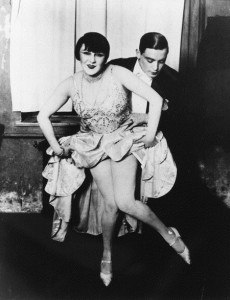The 1920s – alternatively known as the Roaring Twenties, the Jazz Age and the decade of the Bright Young People – is characterised by a generation desperate to leave the horror of war behind them and to create a ‘bright new world’. In the summer of 1920 they danced to new jazzy music from America and wore skimpy dresses and cropped or ‘shingled’ hair that scandalised their Edwardian mothers.

Everything was new, daring and very self-consciously turning its back on the past. In The Jazz Files I have tried to stick as closely as possible to the fashion trends in clothing, music and dance of the period, but was frustrated at times that the more iconic styles that we now readily associate with the 1920s only came to the fore later in the decade.
The Charleston, for instance, was first danced in London clubs in 1924, so even though readers might assume Delilah is dancing the Charleston with her twirling arms and legs, I do not actually call it this. The Black Bottom, however, was certainly danced in 1920 and no one gave two hoots about the racist undertones of its name. This is what Delilah was dancing when Poppy first saw her. Check out this original film footage of a skimpily clad Blackbottom dancer in 1919 and how the dance has been tamed by 1927.
Likewise, the jazz music associated with the period only became common in London clubs a few years later, but in The Jazz Files I have taken some liberties in assuming that Oscars’ Jazz Club might have been ahead of its time. However, the specific jazz songs and tunes that are mentioned in the book had been released in America by 1920 and it might be assumed that they had made their way to British shores via phonographic recordings. I have no evidence however that they were played live in clubs in London so soon after their release. Here is an original recording of the Tiger Rag (1918) by the Original Dixieland Jazzband that features in Chapter Three of The Jazz Files where Poppy gets her first taste of dancing.
Unlike the United States, London in 1920 did not have Prohibition. Jazz clubs like the Kit Kat were popular with the in-crowd and Oscars was modelled on it. I found this fabulous footage of the Kit Kat Club in 1926, courtesy of British Pathe. Enjoy!
Some of the books I used to research the music, dance and lifestyle of the period were:
- Evelyn Waugh’s iconic novel, Vile Bodies (Penguin Modern Classics, 1999, originally published 1930)
- DJ Taylor’s social history Bright Young People: The Rise and Fall of a Generation: 1918-1940 (Vintage, 2008)
- Arnold Shaw’s The Jazz Age: Popular Music in the 1920s (Oxford University Press, 1989)

The Roaring 20 ‘s Film had a section with my Grand parents White & Manning . Dance team . I showed my mom who is now 94 that was the same year that Grandma gave birth to my mom .my mom was Thrilled ! Although Mom herself Traveled with them throughout their Vaudeville Tours as a Child . My Mom was made to perform as a Child in Tour with my Grandparents . Mom didn’t like it though but had many stories for our family. Especially Grandpa and Grandma .
Hi Sean, that’s brilliant! What incredible memories. Which Roaring 20s film was that?